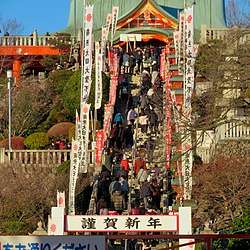Hatsumōde
Hatsumōde (初詣, hatsumōde) is the first Shinto shrine visit of the Japanese New Year. Some people visit a Buddhist temple instead.[1] Many visit on the first, second, or third day of the year as most are off work on those days. Generally, wishes for the new year are made, new omamori (charms or amulets) are bought, and the old ones are returned to the shrine so they can be burned. There are often long lines at major shrines throughout Japan.

Most of the people in Japan are off work from December 29 until January 3 of every year. It is during this time that the house is cleaned, debts are paid, friends and family are visited and gifts are exchanged. It would be customary to spend the early morning of New Year's Day in domestic worship, followed by sake—often containing edible gold flakes—and special celebration food. During the hatsumōde, it is common for men to wear a full kimono—one of the rare chances to see them doing so across a year. The act of worship is generally quite brief and individual and may involve queuing at popular shrines.
Some shrines and temples have millions of visitors over the three days. Meiji Shrine for example had 3.45 million visitors in 1998, and in the first three days of January 2010, 3.2 million people visited Meiji Jingū, 2.98 million Narita-san, 2.96 million Kawasaki Daishi, 2.7 million Fushimi Inari-taisha, and 2.6 million Sumiyoshi Taisha.[2][3] Other popular destinations include Atsuta Jingū, Tsurugaoka Hachimangū, Dazaifu Tenman-gū, and Hikawa Shrine.[4]
A common custom during hatsumōde is to buy a written oracle called omikuji. If your omikuji predicts bad luck you can tie it onto a tree on the shrine grounds, in the hope that its prediction will not come true. The omikuji goes into detail, and tells you how you will do in various areas in your life, such as business and love, for that year. Often a good-luck charm comes with the omikuji when you buy it, that is believed to summon good luck and money your way.
See also
References
- "初詣はいつまでにいけばいい? 正しい作法と開運のポイント". テレ東プラス (in Japanese). TV Tokyo Corporation. 1 January 2020. Archived from the original on 1 January 2020. Retrieved 18 June 2020.
本来は氏神様や菩提寺に新年のご挨拶にいくこと (Translation: Originally it is to give New Year's greetings to one's ancestral shrine or temple)
- Japan's Society Celebrations - Hatsumōde accessed on December 29, 2008
- "'Tis the season for shrines and temples to rake it in". The Japan Times. 3 January 2011. Retrieved 9 May 2011.
- "Encyclopedia of Shinto - Hatsumōde". Kokugakuin University. Retrieved 9 May 2011.